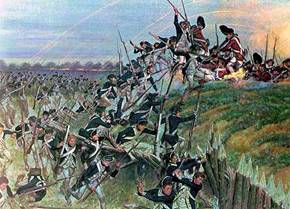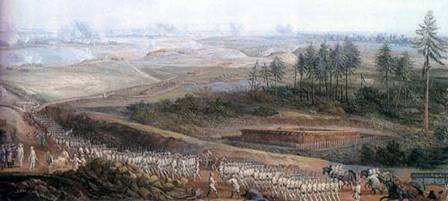Battle of Yorktown - Conflict & Dates:
The Battle of Yorktown was the last major engagement of the American Revolution (1775-1783) and was fought September 28 to October 19, 1781.
Armies & Commanders:
American & French
General George Washington
Lieutenant General Jean-Baptiste Donatien de Vimeur, comte de Rochambeau
8,800 Americans, 7,800 French
British
Lieutenant General Lord Charles Cornwallis
7,500 men
Battle of Yorktown - Background:
|
|
|
American troops storming the redoubt |
In August 1781, General George Washington learned that Lieutenant General Lord Charles Cornwallis' army was encamped near Yorktown, VA. After discussing options with his French ally, Lieutenant General Jean-Baptiste Ponton de Rochambeau, Washington decided to quietly move his army away from New York City with the goal of crushing Cornwallis' isolated force. Departing on August 21, the Franco-American army began marching south. As any success would be dependent upon the French navy's ability to prevent Cornwallis being resupplied, this movement was supported by the fleet of Rear Admiral Comte de Grasse.
Battle of Yorktown - Battle of the Chesapeake:
Arriving in the Chesapeake, de Grasse's ships assumed a blockading position. On September 5, a British fleet led by Rear Admiral Sir Thomas Graves arrived and engaged the French. In the resulting Battle of the Chesapeake, de Grasse succeeded in defeating the British and leading them away from the bay. Disengaging, the French returned to the Chesapeake and resumed blockading Cornwallis' army. Arriving at Williamsburg, Washington met with de Grasse aboard his flagship Ville de Paris on September 17. After securing the admiral's promise to remain in the bay, Washington focused on concentrating his forces.
Battle of Yorktown - the Noose Tightens:
As troops from New York reached Williamsburg, they joined with the forces of the Marquis de Lafayette who had been shadowing Cornwallis' movements. With the army assembled, Washington and Rochambeau began the march to Yorktown on September 28. Arriving outside the town later that day, the two commanders deployed their forces with the Americans on the right and the French on the left. A mixed Franco-American force, led by the Comte de Choissey, was dispatched across the York River to oppose the British position on Gloucester Point.
Battle of Yorktown - Working towards Victory:
|
|
|
French troops advancing to attack the British lines during the Battle of Yorktown. |
In Yorktown, Cornwallis held out hope that a promised relief force of 5,000 men would arrive from New York. Outnumbered more than 2-to-1, he ordered his men to abandon the outer works around the town and fall back to the main line of fortifications. This was later criticized as it would have taken the allies several weeks to reduce these positions by regular siege methods. On the night of October 5/6, the French and Americans began construction of the first siege line. By dawn, a 2,000-yard long trench opposed the southeast side of the British works. Two days later, Washington personally fired the first gun.
For the next three days, French and American guns pounded the British lines around the clock. Feeling his position collapsing, Cornwallis wrote to Lieutenant General Henry Clinton on October 10 calling for aid. The British situation was made worse by a smallpox outbreak within the town. On the night of October 11, Washington's men began work on a second parallel, just 250 yards from the British lines. Progress on this work was impeded by two British fortifications, Redoubts #9 and #10, which prevented the line from reaching the river.
The capture of these positions was assigned to General Count William Deux-Ponts and Colonel Alexander Hamilton. After extensive planning, the attack moved forward on the night of October 14, with Deux-Pont's French troops seizing #9, while Hamilton's Americans captured #10. Immediately after the redoubts were captured, American sappers began extending the siege lines. With the enemy growing nearer, Cornwallis again wrote to Clinton for help and described his situation as "very critical." As the bombardment continued, Cornwallis was pressured into launching an attack against the allied lines on October 16.
Led by Colonel Robert Abercrombie the attack succeeded in taking some prisoners and spiking six guns, but was unable to breakthrough. That night, Cornwallis shifted 1,000 men and his wounded to Gloucester Point with the goal of transferring his army across the river and breaking out to the north. As the boats returned to Yorktown, they were scattered by a storm. Out of ammunition for his guns and unable to shift his army, Cornwallis decided to open negotiations with Washington. At 9:00 AM on October 17, a single drummer mounted the British works and beat the long roll as a lieutenant waved a white flag.
Battle of Yorktown - Aftermath
The fighting at Yorktown cost the allies 72 killed and 180 wounded. British losses were higher and included 156 killed, 326 wounded. In addition, Cornwallis' remaining 7,018 men were taken prisoner. Meeting at the nearby Moore House, Cornwallis attempted to obtain the same favorable terms of surrender that Major General John Burgoyne had received at Saratoga. This was refused by Washington who imposed the same harsh conditions that the British had demanded of Major General Benjamin Lincoln the year before at Charleston.
With no other choice, Cornwallis complied and the final surrender documents were signed on October 19. At noon the French and American armies lined up to await the British surrender. Two hours later the British marched out with flags furled and their bands playing "The World Turned Upside Down." Claiming he was ill, Cornwallis sent Brigadier General Charles O'Hara in his stead. Approaching the allied leadership, O'Hara attempted to surrender to Rochambeau but was instructed by the Frenchman to approach the Americans. As Cornwallis was not present, Washington directed O'Hara to surrender to Lincoln, who was now serving as his second-in-command.
With the surrender complete, Cornwallis' army was taken into custody rather than paroled. Shortly thereafter, Cornwallis was exchanged for Henry Laurens, the former President of the Continental Congress. The victory at Yorktown was the last major engagement of the American Revolution and effectively ended the conflict in the American's favor.




